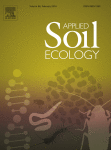Ver ítem
- xmlui.general.dspace_homeCentros Regionales y EEAsCentro Regional Santa FeEEA OliverosArtículos científicosxmlui.ArtifactBrowser.ItemViewer.trail
- Inicio
- Centros Regionales y EEAs
- Centro Regional Santa Fe
- EEA Oliveros
- Artículos científicos
- Ver ítem
Nitrogen balance in a plant-soil system under different cover crop-soybean cropping in Argentina
Resumen
Cover crops (CC) provide many benefits for the soil and the following crop but their effects on nitrogen (N) release and balance in continuous no-tillage soybean (Glycine max L. Merr.) production are little known. Estimation of the biological nitrogen fixation (BNF) in intensive agricultural systems under soybean is essential to understanding the N dynamics and to determining the balances and crop demands. This study (2006–2011) was performed on a Typic
[ver mas...]
Cover crops (CC) provide many benefits for the soil and the following crop but their effects on nitrogen (N) release and balance in continuous no-tillage soybean (Glycine max L. Merr.) production are little known. Estimation of the biological nitrogen fixation (BNF) in intensive agricultural systems under soybean is essential to understanding the N dynamics and to determining the balances and crop demands. This study (2006–2011) was performed on a Typic Argiudoll under no-tillage in the province of Santa Fe, Argentina. The aims were to study the effect of fall winter CC, such as wheat (W), oats (O), oats + vetch (O + V) and vetch (V), on the yield and N-content of the following crop (soybean) and to quantify the contribution of the BNF and N-balance. Three methodologies were used for BNF estimation: 1) a linear regression model between BNF and N-uptake by soybean; 2) the natural 15N abundance in soybean and 3) the average BNF in the Pampa region. Gramineous CC developed more dry matter than pure legume species, with intermediate values for the gramineous-legume mixture. Biological fixation provides 60–70% of absorbed N, according to the estimation method. Within the rainfall range of 500–1000 mm during the soybean cycle, CC did not affect the grain yield or soybean dry matter production. The partial N-balance was always positive, with differences between the techniques used for BNF estimation. Cover crops have contributed to the positive soil N-balance. Gramineous CC stored 22% more N-content in the soil surface layer than the others. Cover crops showed 15% higher index of N-stratification on the surface compared to the control soil. Using CC would be an efficient alternative to produce biomass and to supply N to the soil for the subsequent crop.
[Cerrar]

Autor
Landriscini, María Rosa;
Galantini, Juan Alberto;
Duval, Matias Ezequiel;
Capurro, Julia Ester;
Fuente
Applied Soil Ecology 133 : 124-131 (January 2019)
Fecha
2018-10-10
ISSN
0929-1393
Formato
pdf
Tipo de documento
artículo
Palabras Claves
Derechos de acceso
Restringido
 Excepto donde se diga explicitamente, este item se publica bajo la siguiente descripción: Creative Commons Attribution-NonCommercial-ShareAlike 2.5 Unported (CC BY-NC-SA 2.5)
Excepto donde se diga explicitamente, este item se publica bajo la siguiente descripción: Creative Commons Attribution-NonCommercial-ShareAlike 2.5 Unported (CC BY-NC-SA 2.5)

